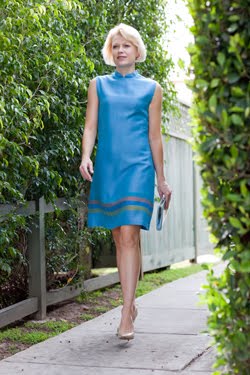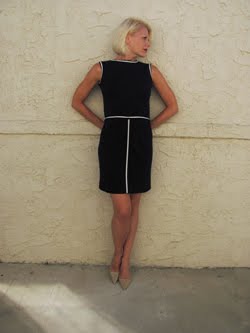When it comes to the HISTORY OF FASHION IN FILM, it all really begins with Gloria Swanson. No one was as associated with style in the early part of the century as Gloria. She was arguably Hollywood's first clothes horse--both on and offscreen--and
she became an international star largely because of the inspiration
audiences found in her fashion. Cecil B. DeMille's Why Change Your Wife? (1920) showcases some of the best of early 1920s style, which was very different than the looks that came later in the decade courtesy of stars like Clara Bow, Joan Crawford, and Louise Brooks. This was a transitional time between the Gibson Girl and the Flapper. Experimentation and drama reigned supreme, and the petite Miss Swanson--only 5' tall--was its undisputed queen. Thus, I started my elite list of The Style Essentials with Why Change Your Wife?--iconic costumes from 1920 that are so shockingly modern, they continue to influence our design today.
Like many early film stars who came from modest means, Gloria's identity and style owed so much to her director and costume designer. In her case, she lucked into two of the best who worked with her again and again--Cecil B. DeMille and Clare West (photo below). Both were at the top of their game in Old Hollywood and took great care of their star. Clare studied in Paris and was an accomplished fashion artist before coming to film, yet another example of a costume designer who began and/or ended their career in fashion. Her very first film happened to be a giant--D.W. Griffith's Birth of a Nation (1915). This led to her working with him again on Intolerance (1916), another giant in film history and one that Photoplay magazine reported was influencing fashion. Though not easily impressed, DeMille was so taken with Clare's talent that he took her away from Griffith and put her in charge of Paramount's wardrobe department. Along with other talents Paul Iribe and Mitchell Leisen, Clare became his costume designer in 1918 and would continue working on some of his biggest pictures until 1925.
DeMille adored Clare for many reasons. First, she was meticulous about research. Like DeMille, her starting point for any historical film had to be based in fact. As a result, her costume research files were still being used by the studios well into the 1950s. Also like DeMille, though, she loved to do things that would "make people gasp." Bigger was always better in his world, and he held a standing edict that any design on the screen should not be
able to be bought in the stores. The clothes should be a spectacle--a reason
for coming to the theater. Along with sex and sets, he recognized that costumes had the power to bring audiences in. Films that did not feature fashion tended to dip or even bomb at the box office. As Gloria once said, "We had clearly found the formula for success...a never-ending parade of fabulous gowns." In this regard, DeMille was
way ahead of his time and helped justify the almost all-inclusive costume design departments of the studio system.
Clare had several sources for Gloria's gowns. At times, she would fly to Paris to shop for her star's wardrobe, whether offscreen or on. Gloria could have 20 costume changes in one film, so stories of spending range anywhere from $150,000 a year to $250,000 a picture. No matter what you believe, these figures are all the more incredible considering this was a time when the average annual salary was only around $1,000. But Clare also understood that the world of fashion was quickly changing and began relying more on her own original designs to make an impact on film. She created clothes that were known for their "outlandish sexual elegance" that included only the most luxurious details, such as pearls and peacock feathers. She saw her clothes making such inroads with audiences that by 1923 she declared to Screen News that Hollywood had begun leading Europe in fashion. Others, such as Adrian at MGM and Howard Greer at Paramount, were quick to agree. They were all witnessing the ascendance of Hollywood style.
It is this style that makes Why Change Your Wife? so exciting. Even more exciting is that this is perhaps the first movie where its leading lady gets a makeover, a story line that would lead to many many others. One of the most successful of the 1920s was Clara Bow's subtle makeover in It (1927) and this popular plot has continued through every decade, such as in favorite films of the 1980s and 90s like Pretty in Pink (1986), Working Girl (1988), and Pretty Woman (1990). They all seem to start here--when dowdy wife Beth (Gloria Swanson) gets dumped for a model, divorces, and then finds fashion. Her ex-husband becomes so smitten with her new look and attitude that he can't take his eyes off her. That went for theater audiences, too.
Unfortunately, many have forgotten the magic of Why Change Your Wife?. Up until a few years ago, it was virtually unheard of and there were only a handful of photos available online. But I'm thrilled to say that since putting a spotlight on it as one of The Style Essentials, there has been a renewed rush of interest. Multiple sites now share stills from the film and sing its praises, particularly focusing on the fashion. This is nothing new to designers, though, who have always found inspiration in Gloria's gorgeous wardrobe. Take a look at the related Cinema Connection post that shows many of Wife's enduring effects on design.
For those who have never seen it, Why Change Your Wife? is currently available in its entirety on GlamAmor's YouTube channel in the 1920s Style Essentials playlist. You can also enjoy several stills from the movie below and see just why Gloria and her costumes are still so significant to fashion.
Unfortunately, many have forgotten the magic of Why Change Your Wife?. Up until a few years ago, it was virtually unheard of and there were only a handful of photos available online. But I'm thrilled to say that since putting a spotlight on it as one of The Style Essentials, there has been a renewed rush of interest. Multiple sites now share stills from the film and sing its praises, particularly focusing on the fashion. This is nothing new to designers, though, who have always found inspiration in Gloria's gorgeous wardrobe. Take a look at the related Cinema Connection post that shows many of Wife's enduring effects on design.
For those who have never seen it, Why Change Your Wife? is currently available in its entirety on GlamAmor's YouTube channel in the 1920s Style Essentials playlist. You can also enjoy several stills from the movie below and see just why Gloria and her costumes are still so significant to fashion.
Beth (Gloria Swanson) shows us the ultimate 'before' (above) as a dowdy wife
and then 'after' as a divorcee who finds herself born again by fashion
Looking good is the best revenge--
Beth's makeover moment poolside (courtesy of costume designer Mitchell Leisen)
impresses everyone, including her now ex-husband
The backs are often my favorite part of 1920s and 1930s dresses...
this standout sequin number from Clare West is but one from this movie that proves my point
This gown shows just how slinky some of these dresses could go--note the barely there straps--
and all the influential 1920s beading and hair accessories
Another sultry gown--this one with feather detail--is almost too much for Beth's ex
A velvet off-the-shoulder gown with a fur-trimmed sleeve
is perfect for fighting off the other woman
proving there is no reason to "change your wife"
Quotes were taken from Columbia University's great Women Film Pioneers Project
and Deborah Landis' book Dressed: A Century of Hollywood Costume Design



































































































4 comments:
Approx. $150,000-$250,000 for gowns per film?! That's quite a budget, but worth it. They are gorgeous!
Also, Gloria S. looks adorable in her eyeglasses as the dowdy housewife. I have got to see this film.
Kimberly, a price tag of $150,000-$250,000 for gowns may have sounded outrageous, but clearly it was worth it. WHY CHANGE YOUR WIFE? is a fun and fascinating look at Gloria Swanson's film and the glamour of the era! Incidently, I first heard of Gloria Swanson from my dear late mother, who was very into health and fitness as well as beauty and glamor, being a fashion model at the time. Thanks for a great post, and I hope you're having a Happy New Year so far! :-)
Thanks Silver Screenings! Yes, the budget is pretty crazy. To clarify, some stories say $150K per YEAR. Some stories say $100-250K per FILM. lol I actually believe the latter because we're talking about couture and original designs by Clare West commissioned by Cecil B. DeMille. He was all about go big or go home. ;)
Definitely see the film (check out GlamAmor's YouTube channel) and let it be a gateway to watch other Gloria films from around this time (if you can find them, that is). They all have pretty incredible fashion.
Thanks Dorian! Great to hear from you. And yes, you get it--those gowns are one of a kind (whether couture or from Clare West) and worth any penny. I love that your mother appreciated her--how amazing to have a mom like you did! I've heard, too, about Gloria's commitment to health, which included a macrobiotic diet and staying away from sugar. How ahead of her time was Gloria?!
Happy 2014 to you! :)
Post a Comment